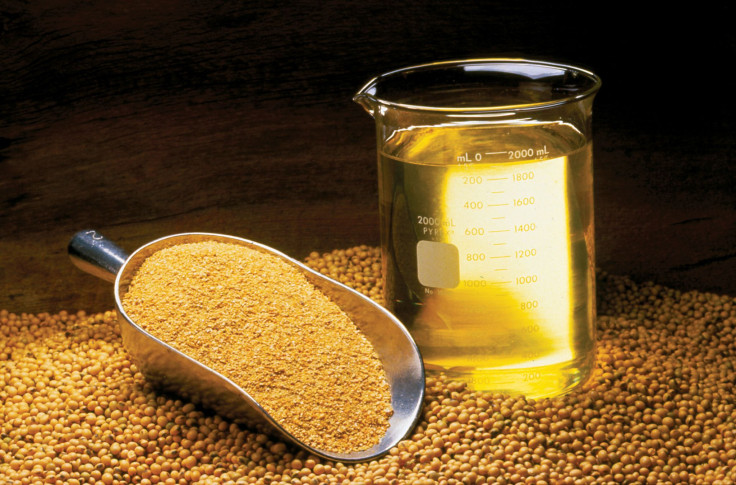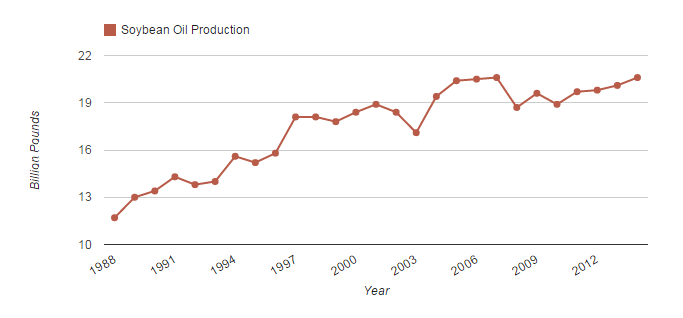Soybeans Make The Unhealthiest Vegetable Oil, Could Lead To Obesity And Type 2 Diabetes: Study

America is the biggest soybean producer in the world and consumes it more than any other vegetable oil. Now, researchers at the University of California, Riverside have just discovered it leads to more cases of obesity and type 2 diabetes than fructose. The study, published in the journal PLOS ONE, is the first to make a side-by-side comparison of soybean to fructose oil. The findings may be used to set future dietary guidelines and nutritional standards within America.
"This was a major surprise for us," said the study’s lead researchers Poonamjot Deol, a professor of cell biology and neuroscience, in a press release, "that soybean oil is causing more obesity and diabetes than fructose, especially when you see headlines everyday about the potential role of sugar consumption in the current obesity epidemic."
Deol and her research team conducted a series of four diets with male mice, each diet designed to mimic the typical American meal. The first group was given coconut oil, the second group given a diet combined of coconut oil and soybean oil, and the third and fourth group were each fed diets with added fructose. Over time, researchers watched as the mice on the high soybean diet gained more weight, produced larger fat deposits, developed a fattier liver with signs of damage, had type 2 diabetes, and insulin resistance.

Diets high in fructose led to less severe metabolic effects than soybean oil; however, they did still lead to negative health effects like kidney problems, and a prolapsed rectum, which is symptomatic of inflammatory bowel disease. The mice on soybean oil-enriched diet gained nearly 25 percent more weight than mice on the coconut oil diet, and nine percent more weight than mice on the fructose diet.
Soybean oil makes up 55 percent of the vegetable oil consumption in the United States, according to The American Soybean Association. Today, Americans eat almost 20 billion more pounds of soybean oil than they did in 1988 — just 26 years ago. It didn’t used to be this way though.
Studies conducted in the 1960s are to blame for the high levels of soybean consumption in the U.S., when researchers found a positive link between saturated fatty acids and the increased risk of cardiovascular disease. Nutritional guidelines changed and reflected the studies’ findings, which led Americans to reduce saturated fat intake of meat and dairy products and to increase their intake of polyunsaturated fatty acids found in plant-based oil-like soybeans.

What is soybean oil truly? Soybean oil is a major fat in the American diet. When a cheap oil like soybean is hydrogenated (hydrogen atoms are chemically added to stiffen its texture), it is solidified and emulsified into food products like margarine, according to the Food and Drug Administration. Soybean oils that are partially hydrogenated may have two to three times the polyunsaturated content as falsely feared saturated fats, which is what ultimately makes it more unhealthy than other plant-based oils.
Aside from the widely-used margarine, soybean oil is notoriously used to manufacture salad dressings, baked goods, crackers, barbecue sauce, non-dairy creamers, shortening, potato chips, mayonnaise, breads, whipped creams, and often used to fry foods. More than 77.5 million acres of soybean crops were planted in 2009, most of which is within the Midwest, according to the U.S. Department of Agriculture. Not only is it frequently consumed by humans, but it is also the primary protein source for feeding livestock like cows and pigs, which in turn humans also consume. The crop has been expanding rapidly, promising a continuous steady flow of soybean oil to American homes.
Source: Deol P. Soybean oil is more obesogenic and diabetogenic than coconut oil and fructose in mouse: potential role for the liver. PLOS ONE. 2015.
Published by Medicaldaily.com



























